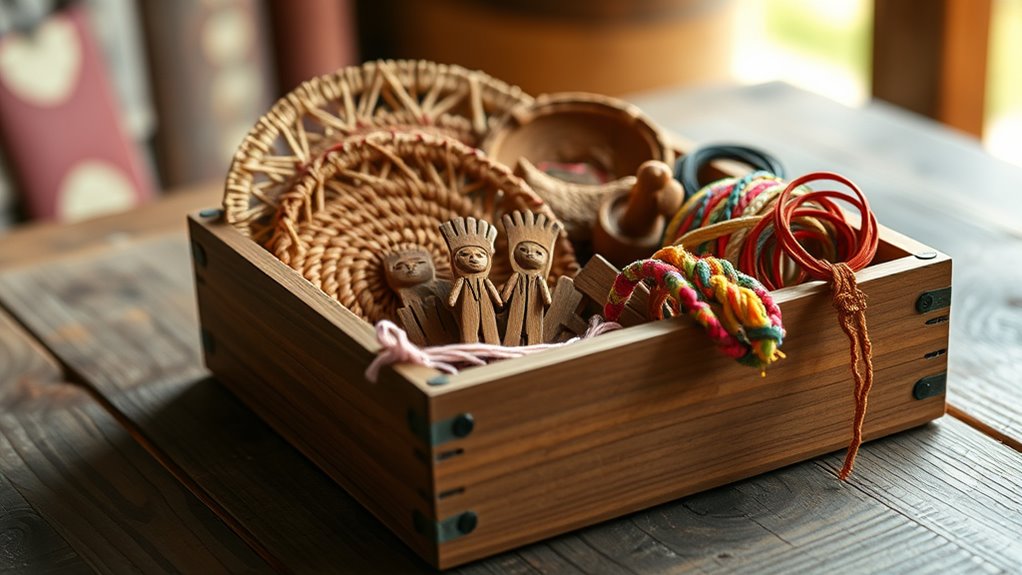Pasalubong is a heartfelt Filipino tradition where small tokens express that you miss someone and care deeply. You choose thoughtful, practical gifts like local delicacies or crafts, presenting them with warmth and genuine smile. These tokens symbolize love, respect, and the effort to maintain your connection despite distance. The thoughtful gesture speaks more than the gift’s value. If you want to learn effective ways to make your pasalubong even more meaningful, keep exploring this meaningful art.
Key Takeaways
- Pasalubong reflects thoughtfulness and emotional connection beyond material value.
- Thoughtful gifts like local delicacies or handicrafts show respect for the recipient’s culture and preferences.
- Present gifts with sincerity, using proper etiquette such as eye contact and neat packaging.
- Personal touches and handwritten notes enhance the emotional significance of small tokens.
- The act of giving itself symbolizes love, appreciation, and maintaining bonds despite physical distance.

When someone you care about travels away, a small token called pasalubong can speak volumes beyond words. It’s more than just a souvenir; it reflects your thoughtfulness and the deep connection you share. In Filipino culture, pasalubong holds a special place because it embodies the act of caring and maintaining bonds despite physical distance. Knowing the cultural significance behind it helps you understand why this gesture is so meaningful. It’s not merely about giving a gift but about expressing love, appreciation, and the desire to share a piece of your life with someone you miss.
Understanding gift giving etiquette is essential when selecting and presenting pasalubong. Traditionally, it’s expected that the gift is thoughtful, practical, or representative of the place visited. You don’t need something expensive—what counts is the effort and thoughtfulness behind it. For instance, bringing home local delicacies, handicrafts, or items unique to the destination shows respect for local culture and consideration for the recipient’s tastes. When giving pasalubong, it’s customary to present it with a warm smile and a few kind words, emphasizing your genuine care. Avoid overly elaborate or ostentatious gifts unless you know the recipient’s preferences well; simplicity and sincerity often speak louder.
Additionally, paying attention to cultural traditions can help ensure your gesture is well-received and appreciated. In Filipino gift giving etiquette, it’s also polite to give something that’s easy to share or enjoy, fostering a sense of togetherness. When handing over the pasalubong, do so with both hands or a gentle handshake and make eye contact, which demonstrates respect and sincerity. If you’re giving multiple items, you might want to organize them neatly and include a short note or message that expresses your thoughts or wishes. This personal touch enhances the emotional value of the gift, making it more than just an object but a symbol of your affection.
Frequently Asked Questions
What Are Traditional Filipino Pasalubong Examples?
When you visit the Philippines, you’ll find traditional pasalubong examples like regional specialties, such as dried mangoes, local coffee, or artisanal chocolates. Handcrafted souvenirs, including woven baskets, wood carvings, and traditional textiles, also make meaningful gifts. These tokens show thoughtfulness and cultural pride, helping you share a piece of your experience with loved ones. Consider selecting items that highlight local craftsmanship and unique flavors for a memorable pasalubong.
How Do I Choose the Right Pasalubong?
Did you know that 78% of Filipinos see pasalubong as a way to express love and appreciation? To choose the right pasalubong, think about its cultural significance and the recipient’s preferences. Consider thoughtful gift selection that reflects their personality and your journey. Personal touches show you care and make the token more meaningful. Trust your instincts, and your gift will surely convey your heartfelt message.
Can Pasalubong Be Given for Reasons Other Than Travel?
Yes, pasalubong can be given for reasons beyond travel. It’s a meaningful way to show emotional gestures and reinforce cultural significance, such as celebrating special occasions, welcoming someone home, or expressing gratitude. You don’t need to travel to give a pasalubong; it’s about connecting and sharing thoughtful tokens that convey your feelings. Giving one in these moments strengthens relationships and highlights the cultural importance of caring gestures.
What Is the History Behind Pasalubong Customs?
You might wonder about the history behind pasalubong customs. These gifts hold deep cultural significance, symbolizing thoughtfulness and strengthening relationships. Originating from indigenous traditions, they evolved through regional variations across the Philippines, reflecting local customs and resources. Over time, pasalubong became a cherished way to show love and gratitude, especially after travel, but their roots lie in the broader cultural practice of sharing and caring within communities.
Are There Specific Occasions for Giving Pasalubong?
You might wonder if there are specific occasions for giving pasalubong. In Filipino culture, gift giving etiquette emphasizes giving these tokens during important moments like travels, festivals, or family reunions. The cultural significance is heartfelt, symbolizing love, gratitude, and thoughtfulness. Whether celebrating milestones or simply showing you care, giving pasalubong strengthens bonds and expresses your feelings in a meaningful way.
Conclusion
So, next time you’re away, don’t just bring home a mug or a keychain—consider a pasalubong that truly screams “I miss you.” Because nothing beats a tiny token that secretly whispers, “I thought of you amidst the chaos,” while you’re busy collecting fridge magnets and souvenir spoons. After all, if your gift doesn’t make them roll their eyes and smile, are you even really saying “I miss you”?









